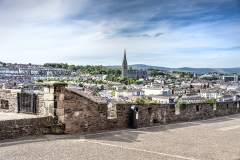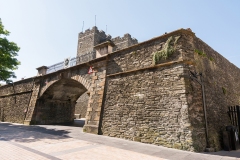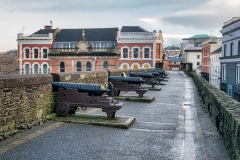Derry City Walls
Derry’s walls were originally built by the Irish Society between 1613 and 1619. They were built with the intention of protecting the Scottish and English planters that had moved to Ulster as part of the Plantation of Ulster that had been established by James I. It was a direct consequence of the previous settlement being destroyed by Irish chieftain Cahir O’Doherty during O’Doherty’s rebellion. As a result of the building of the city’s defences by the Irish Society, which was a consortium of livery companies based out of the City of London, the city was officially renamed Londonderry in the 1613 royal charter. This is what has subsequently led to the naming dispute for the city and county of Derry/Londonderry.
The walls are at the centre of the historic city of Derry and within them are a number of Derry’s most important landmarks including the Apprentice Boy’s Hall and St. Columb’s Cathedral (the first ever purpose build Protestant Cathedral).
History
Siege of Derry
 The Siege of Derry was the first major conflict that occurred during the Williamite War in Ireland. It began when 13 apprentices took the keys for the city’s gates and locked them against the advancing forces of the Earl of Antrim who were loyal to James II. As Antrim did not have enough men to lay siege to the city, he retreated to Coleraine.
The Siege of Derry was the first major conflict that occurred during the Williamite War in Ireland. It began when 13 apprentices took the keys for the city’s gates and locked them against the advancing forces of the Earl of Antrim who were loyal to James II. As Antrim did not have enough men to lay siege to the city, he retreated to Coleraine.
On the 18th of April 1689 the siege would begin in earnest when forces loyal to the king arrived and ordered the city to surrender. Soon James himself would also arrive and ask the city to surrender, but the city refused. The siege would continue until the 1st of August when ships carrying food and supplies broke through the boom across the River Foyle and relieved the city.
The fact that the city’s walls have never been breached gave rise to one of its nicknames; the Maiden City.
Layout
Bishops Street Gate
The walls are about 1 mile in circumference and contain many of the city’s most important landmarks. The entire length of the walls is fully accessible on foot.
There are seven gates in total, four of which were built at the same time as the walls themselves and three were added later.
- Ferryquay gate is one of the original four gates and gave access to the ferryquay on the River Foyle. This was the first gate to be closed by the Apprentice Boys during the siege of Derry.
- Shipquay gate is one of the original four gates and originally gave near direct access to the River Foyle, before the land that became the Guildhall was reclaimed from the River.
- Bishop’s gate is one of the original four gates. The original gate was replaced with a triumphal arch in 1789.
- Butcher’s gate is one of the original four gates and was named for the street immediately inside the walls where many of the city’s butchers were based.
- New gate was built in the 1790s and reinforced during the tensions that lead to the 1798 United Irish rebellion.
- Castle gate was built between 1805 and 1808.
Magazine gate is the most recent gate to be added, being built in 1888 and gave access directly to the riverfront.
Cannons
The walls are lined with numerous cannons that once defended the city during the siege. Derry boasts the largest collection of cannons whose precise origins are known, with many of them being used during the Siege of Derry. In 2005, 24 of the cannons were restored to the former glory, with the famous ‘Roaring Meg’ located at the double bastion near Ferryquay gate.
Text is available under the Creative Commons Attribution-ShareAlike License; additional terms may apply. By using this site, you agree to the Terms of Use and Privacy Policy. Wikipedia® is a registered trademark of the Wikimedia Foundation, Inc., a non-profit organization.





